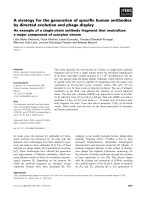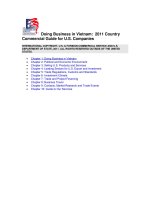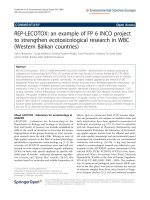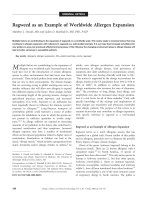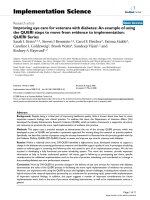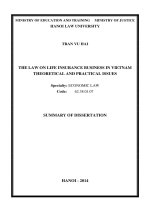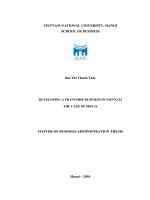Structuring an advertising business in Vietnam (an example of FPT media - the corporation for financing and promoting technology)
Bạn đang xem bản rút gọn của tài liệu. Xem và tải ngay bản đầy đủ của tài liệu tại đây (1019.87 KB, 104 trang )
vietnam national university, HANOI
hanoi school of business
Pham Vu Duc
Structuring an advertising business in
Vietnam (an example of fpt media – the
corporation for financing and
promoting technology)
master of business administration thesis
Hanoi - 2007
vietnam national university, HANOI
hanoi school of business
Pham Vu Duc
Structuring an advertising business in
Vietnam (an example of fpt media – the
corporation for financing and
promoting technology)
Major: Business Administration
Code: 60 34 05
Master of business administration thesis
Supervisors:
1. Dr.Ta ngoc cau
2. ha nguyen, mba
Hanoi – 2007
vi
TABLE OF CONTENTS
ABSTRACT I
ACKNOWLEDGEMENTS V
TABLE
OF
CONTENTS
VI
INTRODUCTION
1
1 BACKROUND 1
2 PURPOSE 1
3 KEY RESEARCH AREAS 2
4 METHODOLOGY 3
5 CONTRIBUTIONS OF THE THESIS 4
6 OUTLINE 4
CHAPTER 1
:
A LITERATURE REVIEW OF THE ORGANIZATIONAL STRUCTURE
6
1.1 BASIC CHALLENGES OF ORGANIZATIONAL DESIGN 6
1.1.1 Four basic organizational design challenges confronting managers and consultants. 6
1.1.2 Using contingency theory to design a structure that fits an organization’s environment
8
1.2 AUTHORITY AND CONTROL IN DESIGNING ORGANIZATIONAL STRUCTURE . 9
1.3 DESIGNING ORGANIZATIONAL STRUCTURE 14
CHAPTER 2: ORGANIZATIONAL STRUCTURE IN ADVERTISING INDUSTRY
27
2.1 OVERVIEW OF ADVERTISING INDUSTRY 27
2.1.1 History 27
2.1.2 What is media? 28
2.1.3 Objectives 30
2.1.4 Future of Advertising industry 33
2.2 ORGANIZATION STRUCTURE OF WORLD ADVERTISING INDUSTRY 34
2.2.1 Types of Ad Agencies 34
2.2.2 Other Types of Agencies and Services 40
2.2.3 Specialized Services 42
2.2.4 Collateral Services 47
2.2.5 Organization Structure of World Advertising Industry 48
2.3 THE ADVERTISING INDUSTRY IN VIETNAM 50
2.3.1 A Decade of Change for Advertising in Vietnam 50
2.3.2 Foreign Advertising Agencies in Vietnam 51
2.3.3 Local Advertising Agencies in Vietnam 52
2.3.4 Future of advertising industry in Vietnam 53
2.4 ORGANIZATIONAL STRUCTURE IN VIETNAM ADVERTISING COMPANY 54
CHAPTER 3: FPT CORPORATION AND FPT MEDIA INTRODUCTION
58
3.1 OVERVIEW OF FPT CORPORATION 58
vii
3.1.1 Business. 58
3.1.2 Products and Services. 59
3.1.3 Organizational Chart 60
3.1.4 Human Resource 61
3.1.5 Organization structure 62
3.2 FPT MEDIA INTRODUCTION 63
3.2.1 Introduction 63
3.3.2. Experience 64
3.3.3 Operations 64
3.3.4 SWOT analysis 65
3.3.5 Current structure 66
CHAPTER 4: SITUATION ANALYSIS AND RECOMMENDATION
70
4.1 SITUATION ANALYSIS 70
4.2 SUITABLE TIME FOR CHOOSING NEW ORGANIZATIONAL STRUCTURE 71
4.3 NEW ORGANIZATIONAL STRUCTURE’S SWOT ANALYST: 79
4.4 IMPLEMENTATION PLAN 81
4.4.1 When will we move to functional organizational structure? 81
4.4.2 Which model will be choosing to implement at this time? 83
CONCLUSION 85
REFERENCES
86
APPENDIX A
WHAT IS ADVERTISING? 88
APPENDIX B
LIST OF SOME BIG ADVERTISING AGENCY IN VIETNAM 90
APPENDIX C
SOMETHING ABOUT ADVERTISING INDUSTRY IN VIETNAM 92
APPENDIX D
TECHNIQUES IN ADVERTISING INDUSTRY
94
APPENDIX E
LIST OF INTERVIEWEES 98
APPENDIX F
AN EXAMPLE OF ORGANIZATIONAL STRUCTURE IN FPT
CORPORATION 100
1
INTRODUCTION
1 BACKROUND
Within scope of this thesis, I would like to study the organizational structure
applying into the advertising industry and especially Vietnam advertising company –
FPT Media, a part of FPT Corporation.
Purpose of the thesis will be presented in the next section.
2 PURPOSE
From the theory, we may found a lot of models that are studied, analyzed and
applied. Each model is designed for certain types of company with its own
particulars: number of employees, business scale and business style. After each
development stage, depending on the situation, managers will decide which model
will be chosen. In some situation, managers may skip certain periods of
development. They are not always successful.
The advertising industry is a partial of every industry. Naturally, it has some its own
particulars which differ from all other fields. Basically, the organizational structure
in advertising firms do not have big different with others but in fact, there are some
their own customizations.
After 4 month in FPT Media, I found that, with a startup company, capital, business
strategy, human resource are important factors. But the organizational structure is
also crucial. An organizational structure has direct impacts on the business.
2
FPT Media, a startup firm, belongs to a big IT corporation in Vietnam, cannot be
outside of the intersection point between organizational structure in theory (which
were designed for all kind of companies); advertising industry (so many kind of
services) and a Vietnam company (with its own characteristics). What is current
organizational structure of FPT Media? Has is got any problem? If yes, how to repair
it? How to make it better?
The purpose of this thesis is to:
First, give out a systematical approach organizational structure theory;
Second, discover the advertising industry;
Third, apply this theory into practical case of FPT Media – FPT corporation
to recommend the best solutions, which will help FPT Media managers have
a guide on how to manage organizational structure effectively;
Fourth, identify some theoretical issue of organizational structure, which can
apply in advertising companies in specific environment of Vietnam.
3 KEY RESEARCH AREAS
The thesis studies organizational structure theories, history and structure of
advertising industry and finally analyzes organizational structure in this industry.
Three first chapters of the thesis are researches on advertising industry and a local
firm with main objectives:
3
To access organizational structure theories
To assess advertising industry and organizational structure in this industry.
To assess a Vietnam firm: their organizational structure – advantage and
disadvantage
4 METHODOLOGY
A lot of related documents on organizational structure theory were gathered,
analyzed, compared and customized for suitable with Vietnam advertising industry.
Sources of information were combined for use includes: books, internet, media, and
dialogues with experts.
Population and Sample
With the first survey (survey A), the author assesses organizational structure in
advertising industry and especially in Vietnam market. There are about nearly 4.000
advertising companies in Vietnam now. As most companies are based in Ho Chi
Minh City (HCMC) – most of big firms and Hanoi, we took the sample of 8
companies in Hanoi and 9 others in HCMC. These 17 companies are big firms (in
total of 40 biggest advertising firms in Vietnam); they cover most of the adverting
market and they provide most of service in adverting industry. This sample is typical
enough to withdraw conclusions about advertising industry and Vietnam advertising
industry. The questionnaires are delivered to one or two key persons in each
company.
The survey B is to identify how FPT Media staff think and satisfy with their
organization. Because FPT Media is a young firm so there are only more than 10
people so author has taken a sample of all of these 10. From this survey, we may
4
found real situation of FPT Media and their real expectation. (See appendix E)
Data collections methods
A lot of data collection methods were considered. Because of constraints in terms of
time, costs and human resources, a random sample from the whole population of
advertising companies could not be obtained in this research. Author has approached
17 big advertising companies in Hanoi and HCMC for the survey.
For survey A, a total of 11 questionnaires were sent via email and 6 questionnaires
were sent by post. Notice phone calls were made in prior and follow up. 8 in total of
11 questionnaires via email were answer and usable. With questionnaires by post, all
6 completed usable questionnaires were collected. Author collected 14 usable
questionnaires over 17 in total.
5 CONTRIBUTIONS OF THE THESIS
The thesis would systematically help Vietnam advertising companies – especially
FPT Media – see what organizational structure is, the benefits and principles to
effectively build organizational structure. Most importantly, the thesis has developed
specific activities, guidelines for Vietnamese advertising firms in understanding and
building an effective organizational structure.
6 OUTLINE
The thesis is divided into four chapters.
Chapter One will review basic organizational structure theories.
Chapter Two and Chapter Three are findings of the relevant issues for the
advertising industry and the company in point – FPT Media.
5
Chapter Four will show recommendations from the case.
6
CHAPTER 1
A LITERATURE REVIEW OF THE ORGANIZATIONAL
STRUCTURE
1.1 BASIC CHALLENGES OF ORGANIZATIONAL DESIGN
If an organization is to remain effective as it changes and grows with its
environment, managers must continuously evaluate they way their organizations are
design: for example, they way work is divided among people and departments, and
the way it controls its human, financial, and physical resources. Organization design
involves difficult choices about how to control – that is, coordinate organizational
tasks and motivate the people who perform them – to maximize an organization’s
ability to create value
1
.
1.1.1 Four basic organizational design challenges confronting
managers and consultants.
People in organization take on new tasks as the need arises and it’s very unclear who
is responsible for what, and who is supposed to report to whom. This makes it
difficult to know on whom to call when the need arises and difficult to coordinate
people’s activities so they work together as a team.
As organizations grow, manager must decide how to control and coordinate the
activities that are required for the organization to create value. The principal design
challenge is how to manage differentiation to achieve organization goals.
Differentiation is the process by which an organization allocates people and
1
Whirlpool, 2002. www.whirlpool.com
7
resources to organizational task and establishes the task and authority relationships
that allow the organization to achieve its goals.
Organizations develop five functions to accomplish their goals and objectives
2
:
support, production, maintenance, adaptive and managerial.
- Support function: Functions which facilitate an organization’s control of its
relations with its environment and its stakeholders. Support function includes
purchasing, sales and marketing, public relations and legal affairs.
- Production function: Function which manages and improves the efficiency of
an organization’s conversion process so that more value is created.
Production functions include production operations, production control, and
quality control.
- Maintenance function: Function which enable an organization to keep its
departments in operation. Maintenance functions include personnel,
engineering and janitorial services
- Adaptive function: Functions which allow an organization to adjust to
changes in the environment. Adaptive functions include research and
development, market research and long-range planning.
- Managerial function: Function which facilitate the control and coordination
of activities within and among department.
An organizational role is a set of task-related behaviors required of an employee.
An organization is composed of interlocking roles that are differentiated by task
responsibilities and task authority. Differentiation has a vertical and a horizontal
dimension. Vertical differentiation refers to the way an organization designs it
hierarchy of authority. Horizontal differentiation refers to the way organization
groups roles into subunits (function and divisions).
Managers confront four design challenges as they coordinate organizational
activities. The choices they make are interrelated and collectively determine how
effectively an organization operates.
2
Ron Ashkenas, Dave Ulrich, Todd Jick and Steve Kerr, 1998. The Boundaryless Organization: Breaking the
Chains of Organizational Structure. New York: Jossey-Bass
8
a) The first challenge is to choose the right extent of vertical and horizontal.
b) The second challenge is to strike an appropriate balance between
differentiation and integration and use appropriate integrating
mechanisms.
c) The third challenge is to strike an appropriate balance between the
centralization and decentralization of decision-making authority.
d) The fourth challenge is to strike an appropriate balance between
standardization and mutual adjustment by using the right amounts of
formalization and socialization.
Differentiation is the process by which organization evolve into complex systems
as they allocate people and resources to organizational task and assign people
different levels of authority.
Different organizational structures cause individuals to behave in different ways.
Mechanistic structures are designed to cause people to behave in predictable
ways. Organic structures promote flexibility and quick response to changing
conditions. Successful organizations strike and appropriate balance between
mechanistic and organic structures.
1.1.2 Using contingency theory to design a structure that fits an
organization’s environment
Contingency approach: A management approach in which the design of an
organization’s structure is tailored to the sources of uncertainty facing an
organization. Contingency theory argues that in order to manage its environment
effectively, an organization should design its structure and control systems to fit
with the environment in which the organization operates.
3
According to this theory, in order to manage its environment effectively, an
organization should design its structure to fit with the environment in which the
3
J. Pfeffer, 1997. Organizations and Organizational Theory
9
organization operates. In other words, an organization must design its internal
structure to control the external environment.
1.2 AUTHORITY AND CONTROL IN DESIGNING
ORGANIZATIONAL STRUCTURE
A basic design challenge is deciding how much authority to centralize at the top of
organizational hierarchy and how much authority to decentralize to middle and
lowest levels
4
. But what determines the shape of an organization’s hierarchy – that is,
the number of levels of authority within an organization – and the span of control at
each level? This question is important because the shape of an organization
determines how effectively the organization’s decision making and communication
system work. Decisions concerning the shape of hierarchy and the balance between
centralized and decentralized decision making establish the extent of vertical
differentiation in an organization.
Stakeholder goals and objectives can be achieved only when organizational skills
and capabilities are controlled through organization structure. The activities of
organizational members would be chaotic without a structure that assigns people to
roles and directs the activities of people and function. An organization should design
their hierarchy of authority and choose control system that creates an effective
organization structure. The shape of hierarchy determines how decision making takes
place. It also determines how motivated people will be pursuer organizational goals.
Designing the hierarchy should be one of management’s major tasks.
1.2.1 The height of an organization’s structure is a function of the number of levels
in the hierarchy, the span of control at each level, and the balance between
centralization and decentralization of authority.
Tall organization: in which the hierarchy has many levels relative to the size of
the organization. Flat organization: the organization that has a few levels in its
hierarchy relative to it size.
4
W. Baker, 2001. The Network Organization in Theory and Practice. Harvard Business Review
10
Figure 2.1 Flat and tall organization
As an organization grows, the increase in the size of the managerial component is
less than proportional to the increase in the size of the organization.
1.2.2 Problems with tall hierarchies include communication, motivation, and
bureaucratic costs
5
.
1.2.2.1. Communication
Having too many hierarchical levels may hinder communication. As the
chain of command lengthens, communication between managers at the
top and the bottom of the hierarchy takes longer. Decision making slows,
and the shutdown hurts the performance of organization that need to
respond quickly to customers; needs or the actions of competitors.
1.2.2.2. Motivation
As the number of levels in the hierarchy increases, the relative difference
in the authority possessed by managers at each level decrease, as does
their area of responsibility. A flat of organization has fewer managers
and hierarchical levels than a tall organization, so a flat organization’s
managers possess relatively more authority and responsibility than a tall
organization’s manager.
Motivation in an organization with a flat structure may be stronger than
motivation in a tall organization.
5
Gareth R. Jones, “Organizational Theory, Design, and change”,Prentice Hall, 2004
11
1.2.2.3. Bureaucratic costs
Managers cost money. The greater number if managers and hierarchy
levels, the greater of bureaucratic cost.
1.2.3 According to the principle of minimum chain of command, an organization
should choose the minimum number if hierarchical levels consistent with the
contingencies it faces.
In other words, the organization should be keep as flat as possible, and managers
should be evaluated for their ability to control organizational activities with the
smallest number of managers possible. An organization with a flat structure will
experience fewer communication, motivation and cost problem that will a tall
organization. The only reason why a organization should choose a tall structure
over a flat structure is that needs a high level of direct control or personal
supervisor over subordinates.
1.2.4 The span of control is the number of subordinates a manager directly
manages.
Organizations that become too tall inevitably experience problems. Nevertheless,
an organization that is growing must control the activities of newly hired
personnel; how can an organization avoid becoming too tall? One way is by
increasing managers’ span of control. If the span of control of each manager
increases as the number of employee increase, then the number of manager or
hierarchical levels does not increase in proportion to increases in the number of
employees.
Figure 2.2 Spans of control
12
CEO
Managers Employee
CEO
The figure depicts two different spans of control. The first one shows an
organization with a CEO, five managers and ten employees, each manager
supervises two people. The second ones shows an organization with a CEO, two
managers and ten employees but manager A supervises two people and manager
B supervises eight people. The reason is the ability of manager.
The two main factors that affect the span of control are task complexity and task
interrelatedness.
1.2.5 The shape of hierarchy and the way it works are also affected by choices
concerning horizontal differentiation, centralization versus decentralization,
differentiation versus integration, standardization versus mutual adjustment, and
the influence of the informal organization.
When there are limits on the usefulness of direct personnel supervisor by
managers, organizations have to find other ways to control their activities.
13
Typically, organizations first increase the level of horizontal differentiation and
then decide in their responses to the design challenges.
Horizontal differentiation leads to emergence of specialized subunits – functions
or divisions.
1.2.6 The six principles of bureaucratic theory specify the most effective way to
design the hierarchy of authority in an organization.
- A bureaucracy is founded on the concept of rational-legal authority
- Organizational roles are held on the basic of technical competence not
because of social status, kinship or heredity
- A role’s task responsibility and decision-making authority and its relationship
to other roles in the organization should be clearly specified
- The organization of roles in a bureaucracy is such that each lower office in
the hierarchy is under the control and supervision of higher office
- Rules, standard operating procedures and norms should be used to control the
behavior and relationships among roles in an organization
- Administrative acts, decisions and rules should be formulated and put in
writing
Bureaucracy has several advantages. It is fair and equitable, and it can promote
organization effectiveness by improving organizational effectiveness by improving
organizational design.
1.2.7 Managers need to recognize how the informal organization affects the way
the formal hierarchy of authority works and make sure the two fit to enhance
organizational performance.
The hierarchy of authority designed by management that allocates people and
resources to organizational task and roles is a blueprint for how things are
supposed to happen. However, at all levels in the organization, decision making
and coordination frequently take place outside the formally designed channels as
people interact informally on the job. Moreover, many of the rules and norms
14
that employees use to perform their task emerge out of informal interactions
between people and not from the formal blueprint and rules established by
managers. Thus, while establishing a formal structure of interrelated roles,
managers are also creating an informal social structure that affects behavior in
ways that may be unintended.
1.2.8 To keep their organizations as flat as possible managers are increasingly
making use of IT and creating self-managed work teams of empowered worker
and/or turning to contingent workers.
1.3 DESIGNING ORGANIZATIONAL STRUCTURE
Designing organizational structure is a difficult and challenging task. Managers have
to manage the vertical and horizontal dimensions of the structure continually and
choose an appropriate allocation of authority and task responsibilities. As an
organization grows and becomes complex, changing its structure to respond to
changing needs or contingencies become important.
Designing a structure that fit a company’s need is a large challenge. Each structure
has advantages and disadvantages, and managers have to be ready and willing to
redesign the organization in order to obtain the advantages and anticipate and
minimize the problems of whichever structure they choose. An organization that is in
control of it structure has an important competitive advantage over one that is not.
Many organizations ignore the coordination problems inherent in the organizing
process. Too often, an organization waits until it is already in trouble (in decline)
before attempting to deal with coordination and motivation problems. The
characteristic of the top manager team are very important in this regard because they
determine how decision get make and how top managers perceive the problems the
organization is experiencing.
15
1.3.1 A functional structure is a design that groups people because they have
similar skills or use the same resources. Functional groups include finance, R&D,
marketing, and engineering. All organizations begin as functional structures.
6
Figure 2.3 A sample of functional structure
CEO
Production
Department
Program
Department
Media
Department
Account
Department
Admin
This model provides people with the opportunity to learn from another and
become more specialized and productive. When people with skills in
common are assembled into a function group, they can learn the best way to
solve the problems, or the most efficient techniques for performing a task,
from one another.
Another advantage of functional structure is that people who are grouped
together by common skills can supervise one another and control each other’s
behavior. The final advantage, people in a function who work closely with
each other over extended time periods develop norms and values that allow
them to become more effective at what they do.
1.3.2 An organization need to adopt a more complex structure when it starts to
produce many products or when it confronts special needs, such as the need to
produce new products quickly, to deal with different customer groups, or to
handle growth into new regions
7
1.3.3 The move to a new complex structure is based on three design choices:
increasing vertical differentiation, increasing horizontal differentiation, and
increasing integration.
8
6
Gareth R. Jones, “Organizational Theory, Design, and change”,Prentice Hall, 2004, p.160
7
J. Child, 1977. Organization: A Guide for Managers and Administrators. New York: Harper and Row.
8
Gareth R. Jones, “Organizational Theory, Design, and change”,Prentice Hall, 2004.
16
1.3.3.1. Increasing vertical differentiation: To regain control in a vertical
direction, the organization needs to increase vertical differentiation. This
typically involves:
- Increasing the number of levels in the hierarchy
- Deciding how much decision-making authority to centralize at the top of
the organization.
- Deciding how much to use rules, SOPs, and norms to standardize behaviors
and hence exert control over low-level employees.
1.3.3.2. Increasing horizontal differentiation: To regain control in a horizontal
direction, the organization needs to increase horizontal differentiation. This
involves overlaying a functional grouping with some other kind of submit
grouping – most often, self-contained product terms or product divisions
that process all the function resource they need to meet their goals.
CEO
Production
Department
Program
Department
Media
Department
Account
Department
Admin
Vertical
Horizontal
Figure 2.4 Vertical and horizontal differentiation
1.3.3.3. Increasing integration: To regain control in both vertically and
horizontally, the organization needs to increase integration between subunits.
The higher the level of differentiation, the more complex the integrating
mechanisms that an organization needs in order to control its activities.
1.3.4 Most organizations move from a functional structure to some kind of
divisional structure: a product structure, a geographic structure, or a market
structure.
9
9
H. Mintberg, 1987. The Structuring of Organizational Structures. New Jersey: Prentice Hall
17
The structure that organizations most commonly adopt to solve the control
problems that result from producing many different kinds of products in
many different locations for many different type of clients is the divisional
structure. A divisional structure groups functions according to the specific
demands of products, markets, or customers. The goal behind the change to a
division structure is to create smaller, more manageable submits within an
organization. The types of divisional structure managers select depend on the
specific control problem to be solved:
If the control problem is due to the number and complexity of
products, the organization will divide its activities by product and use
a product structure.
If the control problem is due to the number of locations in which the
organization products and sells its products, the organization will
divide its activities be region and use a geographic structure.
If the control problem is due to the need to service a large number of
different customer groups, the organization will divide its activities by
customer group and use a market structure.
1.3.5 There are three kinds of product structure: product division structure,
multidivisional structure, and product team structure.
10
1.3.5.1. Product division structure is used when an organization produces
broadly similar products that use the same set of support functions.
Figure 2.5 Product division structure
10
Gareth R. Jones, “Organizational Theory, Design, and change”,Prentice Hall, 2004.
18
CEO
Vice President
Financial
Vice President
Research & Development
Vice President
Sale & Marketing
Vice President
Material
PDM PDM PDMPDM
Soup
Division
Meat
Division
Fish
Divison
Baked
Goods
Division
PDM
Central support
functions
Product Division
Manager
1.3.5.2. Multidivisional structures are available to organizations that are
growing rapidly and producing a wide variety of products or are entering
totally different kinds of industries.
Figure 2.6 Multidivisional structure
CEO
Senior Vice President
Research & Development
Senior Vice President
Financial
Senior Vice President
Marketing
Senior Vice
President Materials
Corporate Headquarters Staff
Division A Division B Division C Division D
Support functions Support functionsSupport functionsSupport functions
Corporate
managers
Divisional
managers
Functional
managers
Each division is dependent and has its own set of support functions.
The corporate headquarters staff oversees the activities of the
divisional managers, and there are three levels of management:
corporate, divisional and functional.
In a multidivisional structure, each product division is a self-contained
19
division with the operating structure that best suits it needs. A central
headquarters staff is responsible for coordinating the activities of the
division in the organization. When a lot of coordination between
divisions is required, a company can use a multidivisional matrix
structure.
Figure 2.7 A Multidivisional structure in which division has a
different structure
CEO
Senior Vice President
Research & Development
Senior Vice President
Financial
Senior Vice President
Marketing
Senior Vice President
Materials
Corporate Headquarters Staff
General Manager President President
Functional Groups
Functional GroupsFunctional Groups
Functional Structure Product Division Structure
Matrix Structure
Advantages of the multidivisional structures:
Increased organizational effectiveness
Increased control
Profitable growth
Internal labor market
Disadvantages of the multidivisional structures:
Managing the corporate divisional relationship
Coordination problem between division
Transfer pricing
Bureaucratic costs
20
Communication problems
1.3.5.3. Product team structure put the focus on the product being the
produced. Teams of functional specialists are organized around the product
to speed product development.
Figure 2.8 Product team structure
CEO
Senior Vice President
Research & Development
Senior Vice President
Financial
Senior Vice President
Marketing
Senior Vice President
Materials
PTM PTMPTMPTM
Product
Division
Product
Division
Product
Division
Product
Division
Functions
Product
Development
Teams
PTM : Product Team Manager
Each product team manager (PTM) supervises the activities associated
with developing and manufacturing a product.
1.3.6 Geographic structures are used the organizations expand into new areas or
begin to manufacture in many different locations.
11
This is one of three types of product structure, the multidivisional structure is
the one most often used by large organizations. It provides the extra control
that is important then a company produces a wide array of complex products
or services or enters new industries and needs to deal with different sets of
stakeholders and competitive forces. However, when the control problems
that the companies experience are a function of geography, a geographic
division structure, in which divisions are organized according to the
requirements of the different locations in which an organization operates, is
11
Richard H. Hall, and Pamela S. Tolbert, 1999. Organizations: Structures, Processes, and Outcomes (4th Edition),
Prentice Hall. Gareth R. Jones, “Organizational Theory, Design, and change”,Prentice Hall, 2004.
21
available.
Figure 2.9 Geographic structure
Central support
functions
CEO
Regional
Operations
Regional
Operations
Regional
Operations
Regional
Operations
Individual stores
1.3.7 Market structures are used when organizations wish to group activities to
focus on the need of distinct customer groups.
12
Each customer group has a different marketing focus, and the job of each
group is to develop products to suit the needs of its specific customers. Each
group makes use of centralized support functions.
Figure 2.10 Market structure
12
Richard H. Hall, and Pamela S. Tolbert, 1999. Organizations: Structures, Processes, and Outcomes (4th Edition),
Prentice Hall. Gareth R. Jones, “Organizational Theory, Design, and change”,Prentice Hall, 2004.
